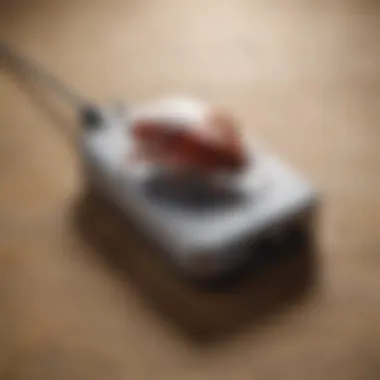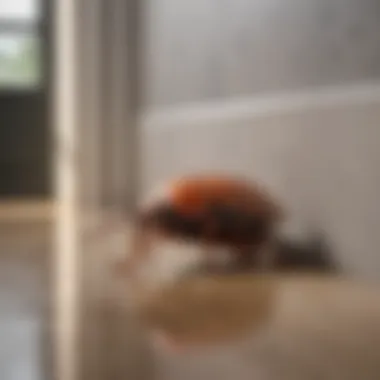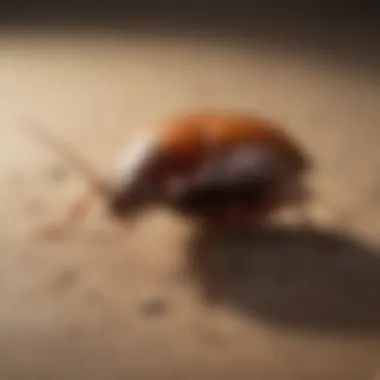Exploring Effective Plug-Ins for Cockroach Control


Intro
The presence of cockroaches in homes can induce anxiety and necessitate effective control strategies. These pests are not just a nuisance; they can pose health risks by contaminating food and surfaces. Understanding cockroach behavior and the methods to repel them is essential for every homeowner. Plug-in devices, designed specifically to deter cockroaches, have gained popularity. This article will explore these devices in depth, addressing their mechanisms, efficacy, and proper usage.
Understanding Pests
Cockroaches are resilient insects that thrive in various environments, especially in urban settings. Their ability to reproduce quickly makes them a persistent challenge for homeowners.
Definition of Pests
Pests are organisms that harm human interests, particularly when they invade living spaces. Cockroaches fall into this category due to their role as disease vectors and their potential impact on food hygiene.
Importance of Pest Identification
Identifying the type of pest is crucial for effective control. Different cockroach species may require distinct approaches for management. By understanding their habits, one can improve the chances of finding a suitable repellent solution.
Prevention Techniques
It is vital to incorporate prevention into pest management strategies. Effective prevention can substantially reduce the likelihood of infestations, providing a proactive approach before reliance on plug-in devices.
Home and Garden Preventative Measures
Preventing cockroach ingress often begins with proper sanitation. Here are some recommended practices:
- Seal cracks and crevices around doors and windows.
- Keep food in sealed containers.
- Dispose of trash regularly and use tight-fitting lids.
- Maintain a clean and dry environment, as cockroaches are attracted to moisture.
Seasonal Prevention Tips
Cockroach activity can vary with the seasons. As temperatures drop, they may seek shelter indoors. Homeowners should take extra precautions in colder months:
- Inspect potential entry points in the fall.
- Use weather stripping to seal gaps around doors.
- Monitor for signs of moisture buildup in basements or other areas.
Eco-Friendly Pest Control Solutions
With increasing awareness of environmental sustainability, many homeowners seek eco-friendly pest control methods. This section will discuss these alternative approaches for managing cockroach populations.
Overview of Sustainable Practices
Sustainable practices include strategies that prioritize ecological balance. This might entail using biodegradable products or preventing the introduction of toxic chemicals into the home. Implementing these practices can promote more sustainable living.
Natural Remedies and Their Effectiveness
Home remedies often involve common household items. For instance, the use of boric acid or natural oils like peppermint and eucalyptus can deter cockroaches effectively. However, their effectiveness varies and should be used as supplementary to other measures.
"Effective pest management combines awareness, prevention, and responsible usage of available tools to protect our living spaces."
This comprehensive approach enables a multifaceted defense strategy, combining knowledge of pests with practical measures. By employing both preventative measures and sustainable practices, homeowners can significantly enhance their pest control efforts.
Prolusion to Cockroach Infestations
Cockroach infestations can cause significant discomfort in any home. These pests are not only unsightly but can also pose serious health risks. Understanding the dynamics of infestations is essential for effective control. In this article, we will explore plug-in devices, a modern solution for managing these unwelcome guests. Knowing how cockroaches behave, the various species, and health concerns related to them will help us appreciate the role of technology in pest control.
Understanding Cockroach Behavior
Cockroaches are nocturnal creatures, often seeking food and shelter in places that are dark and warm. They have an acute sense of smell that helps them locate food sources. Their ability to reproduce quickly makes infestations grow rapidly if not addressed. Cockroaches prefer to hide in crevices, around pipes, and in furniture, making detection challenging. Understanding these behaviors is crucial for both prevention and implementation of control measures.
Common Cockroach Species
There are several species of cockroaches that homeowners may encounter. Each has unique characteristics and habits, which contribute to their ability to survive in various environments.
German Cockroach


The German cockroach is one of the most prevalent species in urban structures. It is small, usually about half an inch long, and characterized by two horizontal stripes on its pronotum. This species is prolific and can multiply quickly, often leading to severe infestations. Its adaptability to diverse environments makes it a consistent challenge for homeowners.
German cockroaches seek out warm, moist areas close to food sources, such as kitchens and bathrooms. Their rapid breeding cycle means that if you see one, there are likely many more hidden nearby.
American Cockroach
The American cockroach is larger, reaching up to two inches in length. By nature, it is more often found in outdoor environments but will venture indoors in search of food and warmth. They are reddish-brown with a distinctive yellowish figure on the back of their heads. Although they tend to be more of a nuisance than a health risk, their presence might indicate poor sanitation conditions. American cockroaches can live for a long time without food, further complicating eradication efforts.
Oriental Cockroach
This species prefers cool, damp environments, making basements and sewers their typical habitats. The Oriental cockroach is dark brown to black and grows about one to one and a half inches long. They do not fly, which differentiates them from other species. Their preference for moisture can lead them into plumbing and waste areas, contributing to odors and deteriorated hygiene conditions in homes. Because they prefer unclean environments, their presence often signals an underlying sanitation problem that needs urgent attention.
Health and Safety Concerns
Cockroaches are known carriers of various pathogens, which can contribute to health issues such as allergies and asthma, particularly in sensitive individuals. They can contaminate food and surfaces, posing risks especially for children and other vulnerable groups. Additionally, the feces and body parts of these insects can trigger allergic reactions. Understanding the health implications of cockroach infestations highlights the importance of effective control measures, including plug-in devices.
The Role of Plug-In Devices
Plug-in devices represent an innovative approach to cockroach control, integrating technology into pest management strategies. They are designed to deter cockroaches through various methods, making them an appealing option for homeowners seeking non-toxic solutions. Understanding their role in the fight against infestations is critical for effective pest management.
Plug-ins operate primarily by emitting sound waves or electromagnetic fields that target pest behavior. This proactive approach can support a comprehensive pest control plan by providing a continuous deterrent without the need for harmful chemicals.
Adopting plug-in devices can significantly shift how homeowners manage pest issues. They offer convenience and integration with broader pest control strategies. Additionally, their rising popularity speaks to their convenience and perceived safety.
How Plug-Ins Work
Ultrasonic Frequency Emissions
Ultrasonic frequency emissions are sound waves that fall above the range of human hearing. These devices generate repeated sounds designed to disrupt a cockroach's normal behavior, thereby causing stress and disorientation. The key characteristic of this technology is its ability to affect hearing organisms without causing physical harm.
The unique feature of ultrasonic emitters is that they create a hostile environment for pests, prompting them to leave treated areas. This method tends to be popular because it does not rely on chemicals, providing a non-toxic control method. However, results can vary based on placement and environmental factors, which may limit effectiveness in some scenarios.
Electromagnetic Waves
Electromagnetic waves utilize changes in the electromagnetic fields in environments to affect pest behavior. This method hinges on the principle of interfering with how pests communicate and navigate their environment. The key characteristic of these devices is the adaptability of the frequency, which can potentially target multiple pest species.
What sets electromagnetic wave devices apart is their broad spectrum of influence. By affecting pests on a larger scale, they can work in multi-room situations. However, there is some debate about the consistent effectiveness of this method, as results may differ based on the specific device used and the construction materials in the home.
Advantages of Using Plug-Ins
Non-Toxic Solutions
One of the most significant advantages of plug-in devices is their non-toxic nature. Homeowners can control pest problems without risking exposure to harmful chemicals. Plug-ins offer a sustainable pest control solution that aligns with modern eco-friendly practices. Consumers increasingly prefer non-toxic options for health and environmental reasons.
The unique feature of these solutions is their role in integrated pest management, allowing users to combine them with other methods without conflicting safety concerns. Nevertheless, some users may doubt their effectiveness compared to traditional chemicals, leading to skepticism in some cases.
Ease of Use
The practical design of plug-in devices contributes greatly to their popularity. These devices require minimal setup and can be plugged directly into electrical outlets, which means no additional tools or preparations are necessary. Ease of use encourages consistent application, as homeowners do not need to remember complicated procedures.
An intuitive design feature adds to their appeal, allowing users to place them in strategic locations easily. This convenience does not mean that they work universally everywhere. Effectiveness may depend on careful placement and the specific characteristics of the living space.
Cost-Effectiveness
Cost-effectiveness is another critical aspect of plug-in devices. Although initial investment may appear moderate compared to traditional pest control options, lasting utility makes them a cost-efficient choice in the long run. They usually do not require frequent replacements or extensive maintenance, which adds to their economical benefit.
The unique feature of this value lies in their ability to offer long-term pest deterrent solutions without ongoing costs for chemicals. Notably, some users may not realize the true potential savings, thinking upfront expenses are indicative of limited utility.
Limitations and Misconceptions
Despite their benefits, plug-in devices come with limitations. Users often have misconceptions about their capabilities. Many assume that plug-ins will provide instant results, but actual effectiveness can take time, depending on numerous factors such as infestation severity.
Furthermore, some believe that plug-ins alone will completely eliminate pests, ignoring the need for complementary pest control methods. Regular monitoring is essential, as a combined approach will likely yield better outcomes in managing cockroach populations.


"While plug-in devices are a promising solution, they should not be seen as a standalone answer to pest problems."
Understanding these aspects is crucial for homeowners looking to incorporate plug-in devices into their pest management strategies.
Types of Plug-In Devices Available
Understanding the various types of plug-in devices is essential to effectively control cockroach populations. These devices exploit different technologies and methodologies to repel pests. Knowing what is available helps homeowners choose solutions that align with their specific needs. Here, we delve into three primary categories: ultrasonic repellers, electromagnetic repellers, and combo devices.
Ultrasonic Repellers
Functionality
Ultrasonic repellers function by emitting high-frequency sound waves that are inaudible to humans but disturb pests such as cockroaches. These sounds create an uncomfortable environment for the insects, encouraging them to vacate the area. The key characteristic of these devices is their reliance on sound waves as a deterrent. Their popularity stems from the non-toxic nature of the solution, making it a safe choice for families with children and pets. However, the effectiveness of ultrasonic repellers can vary based on obstacles like walls and furniture that may block sound waves. Their limited range and interference from other household devices can be a disadvantage.
Recommended Brands
When looking for ultrasonice repellers, certain brands have gained recognition for their effectiveness. Brands like Pest Soldier and Neatmaster are known for high-quality devices that offer reliable performance. A key feature of these brands is their design—often compact and aesthetically pleasing, making them easy to integrate into any room. They are generally affordable, providing good value for the capabilities they offer. However, some users report mixed experiences, suggesting that while they may work well in some environments, their performance can be erratic in others.
Electromagnetic Repellers
How They Differ from Ultrasonic
Electromagnetic repellers operate on a different principle. Instead of sound waves, they use electromagnetic fields to disrupt the communication and behavior of pests. This distinction is crucial as it affects how these devices are applied in homes. The characteristic of electromagnetic repellers is their ability to penetrate walls and barriers more effectively than sonic devices. This feature can make them a more desirable option for larger spaces. However, their effectiveness can still be influenced by the layout of the home. Additionally, some users may find them less familiar than ultrasonic options, leading to varied acceptance.
User Experiences
Feedback from users regarding electromagnetic repellers tends to show a divergence of opinions. Many individuals report satisfaction with the results in terms of reduced sightings of cockroaches. The unique feature here is the relatively quick results some users experience compared to other methods. However, there are also those who express skepticism, feeling that these devices do not work as advertised. The variability in user experiences suggests that environmental factors play a significant role in the success of electromagnetic repellers.
Combo Devices
Hybrid Mechanisms
Combo devices combine features of both ultrasonic and electromagnetic technologies. They appeal to homeowners looking for a versatile solution. The key characteristic of hybrid mechanisms lies in their dual-action functionality. By leveraging both sound and electromagnetic fields, these devices aim to maximize effectiveness. This feature provides a broader range of protection, targeting different pest behaviors. While they tend to be more expensive than single-function devices, the potential benefits can justify the cost for many users.
Effectiveness Reviews
Reviewing the effectiveness of combo devices can offer valuable insights into their utility in pest control. Many reviews highlight their comprehensive approach, often noting significant reductions in cockroach activity after a short period of use. The multifaceted strategy of these devices is a compelling characteristic, especially for homeowners dealing with persistent infestations. However, they are not without scrutiny; some users still report limited success, indicating that as with any pest control method, results can vary. It's crucial for homeowners to consider their unique situations when evaluating these devices.
The effectiveness of plug-in devices often depends on their placement and the specific circumstances of a home.
In summary, understanding the types of plug-in devices available provides a foundation for selecting the right solution for cockroach control. Each device has its distinct characteristics, advantages, and disadvantages that should be carefully evaluated.
Evaluating Effectiveness of Plug-Ins
Evaluating the effectiveness of plug-ins for cockroach control is crucial for homeowners who face the threat of infestation. The ability to discern whether these devices truly work can save time, money, and stress. Ensuring that a plug-in device performs well in repelling cockroaches influences decision-making and enhances safety in the home environment. Given the various options available, understanding the effectiveness of these devices is vital not only for pest management but also for ensuring a healthy living space.
Scientific Evidence and Studies
Research regarding plug-in devices provides insights into their efficiency and viability. Various studies have explored how ultrasonic and electromagnetic frequencies can affect cockroaches. Some scientific evidence suggests a reduction in cockroach activity in areas where these devices are deployed. For instance, a study conducted by the University of Florida revealed that ultrasonic repellers showed some effectiveness in driving away cockroaches, though results varied by species.
However, it is important to note that different environments and situations can significantly affect outcomes. Factors such as room size, the number of infestations, and competing pest solutions all play a role in determining how well these devices perform. Thus, while scientific evidence exists, cautious interpretation is necessary.
User Testimonials
User testimonials offer a perspective that complements scientific studies. Many homeowners report mixed results with plug-in devices. Some users express satisfaction with the significant decrease in cockroach sightings after using these devices. They often attribute this success to a combination of the plug-ins and vigilant cleanliness practices. Others, however, have voiced disappointment, noting that they noticed little difference in pest activity.
When assessing reviews, it becomes essential to consider the context in which users employed the devices. Those who combined plug-ins with traditional pest control methods often reported better results. Individual experiences can vary widely, emphasizing the need for users to note their specific circumstances when evaluating effectiveness.
Expert Opinions
Experts in pest control provide valuable insights into the utilization of plug-in devices. Many pest control professionals emphasize that while plug-ins can serve as part of an integrated pest management strategy, they should not be solely relied upon. According to Dr. Larry McDaniel, a pest management consultant, these devices can provide a supplementary layer of protection but are most effective when used alongside other methods like regular cleaning and monitoring.


Furthermore, experts warn against adopting a solely passive approach by only relying on plug-ins. They suggest homeowners adopt a proactive stance that includes sealing cracks, minimizing potential food sources, and using professional pest services in cases of severe infestation. This multi-faceted approach ensures a more comprehensive solution to cockroach control.
"Plug-ins can contribute to pest repulsion, but they should work in conjunction with sound practices and, when needed, professional pest control." - Dr. Larry McDaniel
Best Practices for Using Plug-Ins
Using plug-in devices for cockroach control requires a thoughtful approach to maximize their effectiveness and ensure a pest-free environment. It is essential for homeowners to understand not only how these devices operate but also how to integrate them into a broader pest control strategy. Adopting best practices can lead to better outcomes, reduced frustration, and more importantly, an effective long-term solution.
Placement Strategies
Proper placement of plug-in devices is crucial for their effectiveness. Many homeowners underestimate the importance of positioning, which significantly impacts how well the devices repel cockroaches. Here are key considerations for effective placement:
- Room Distribution: Place devices in rooms where cockroach activity has been observed, such as kitchens, bathrooms, and basements. The more areas you cover, the better results you can expect.
- Elevated Positioning: Install plug-ins at a height that corresponds to where cockroaches typically roam. These pests tend to stay close to the ground, so placing devices on the floor or lower shelves may reduce their efficiency.
- Avoid Obstructions: Ensure that there are no furniture items or obstacles blocking the device. Ultrasonic waves need a clear pathway to be effective.
- Wall Outlets: Using wall sockets that are centrally located in a room can provide a greater range of coverage. When installing multiple devices, keep them about 6 feet apart to avoid interference.
Following these placement strategies can make a significant difference in how well plug-in devices work against cockroach infestations.
Complementary Pest Control Methods
While plug-in devices can contribute to better pest management, they should not be the sole approach to cockroach control. Complementary methods can bolster their effectiveness and lead to more comprehensive pest management. Here are some methods to consider:
- Regular Cleaning: Maintaining a clean environment is critical. Cockroaches are attracted to food residue and garbage. Regularly clean kitchens, bathrooms, and living areas to eliminate hiding spots and food sources.
- Seal Entry Points: Inspect your home for cracks and crevices where cockroaches may enter. Sealing these entry points with caulk or other materials can drastically decrease the likelihood of an infestation.
- Bait Stations: While plug-ins repel, bait stations can attract and kill cockroaches. Placing these strategically in areas of known activity can help reduce cockroach populations effectively.
- Keep Moisture in Check: Cockroaches thrive in humid environments. Repair leaks and ensure proper ventilation in damp areas, as this will also discourage their presence.
By combining plug-in devices with these complementary methods, homeowners can create a more effective and sustainable approach to cockroach control.
Assessing Cost and Value
When considering plug-in devices for cockroach control, evaluating cost and value is critical. Households are often looking for effective solutions that do not strain the budget. A clear understanding of the financial aspects empowers homeowners to make informed decisions. This section discusses the price range of different devices and analyzes their long-term investment potential, ensuring that families invest wisely in pest control solutions.
Price Range of Different Devices
The price of plug-in cockroach repellers can vary significantly based on several factors, including technology type, brand, and additional features. Most ultrasonic devices fall within the price range of $20 to $100. More advanced electromagnetic options may cost between $30 and $120. Combo devices, integrating both technologies, typically range from $50 to $150.
Homeowners should also consider the following:
- Functionality: Higher-priced models may provide more effective ranges or additional features such as indicator lights or timers.
- Brand Reputation: Established brands may charge a premium due to their reliability and effectiveness.
- User Reviews: Reading testimonials can offer insights into the value derived at different price points.
It is advisable to compare the features and performance of devices within your budget to find the best value overall.
Long-Term Investment Analysis
Investing in a plug-in cockroach repeller can be viewed through the lens of long-term value. These devices typically have a longer lifespan than traditional roach control methods, such as sprays or baits. Plug-ins require minimal maintenance and may lead to cost savings over time.
Consider the following factors:
- Preventive Cost: Investing early in a plug-in device can prevent larger infestations that require costly professional pest control services later.
- Potential Savings: Many users report reduced spending on cleaning products, as plug-ins can help limit the spread of droppings and allergens associated with cockroach infestations.
- Ease of Use: Plug-ins require minimal effort, unlike chemical sprays that demand application and reapplication.
"Investing in pest control devices not only saves money but also provides peace of mind, ensuring a healthier home environment."
When assessing overall value, remember that the effectiveness of these devices varies. A small upfront cost may yield substantial savings and benefits in health and home quality over time.
End
In concluding this exploration of plug-in devices for cockroach control, it is essential to grasp the implications of the findings discussed. The topic is significant as it combines insights into non-toxic pest management with practical applications suitable for modern households. Plug-ins represent a unique intersection of technology and everyday problem-solving. They offer solutions that appeal to eco-conscious homeowners who prefer to avoid chemical interventions.
Summary of Key Findings
The investigation has highlighted several key findings:
- Mechanisms of Action: Plug-ins utilize ultrasonic frequencies and electromagnetic waves to deter cockroaches. However, the effectiveness of these methods varies among different species of cockroaches.
- User Experiences: User testimonials provide mixed reviews, suggesting that effectiveness can depend on placement and environmental factors. While some users reported success, others noted limited impact, which underscores the importance of realistic expectations.
- Cost-Efficiency: Compared to traditional pest control methods, the initial investment in plug-in devices can be appealing. However, their potential longevity and the need for complementary strategies must be factored into any cost analysis.
Recommendations for Homeowners
Homeowners considering plug-in devices should keep several recommendations in mind:
- Evaluate Placement: The effectiveness of plug-ins heavily relies on where they are located. Strategic placement in areas where cockroaches are likely to enter or harbor is vital. Consider using multiple devices in larger spaces.
- Combine Methods: Integrate plug-ins with other pest control strategies. Regular cleaning, sealing entry points, and monitoring for signs of infestation can enhance the overall effectiveness.
- Research Products: Not all plug-in devices are equally effective. Homeowners should read reviews and examine scientific studies to select reputable brands. Understanding the differences in technology can lead to better-informed choices.
- Manage Expectations: It is important to manage expectations about the effectiveness of plug-in devices. While they are a helpful part of a broader pest management strategy, they should not be the sole method of control.
By synthesizing these findings and recommendations, this article serves as a guide for homeowners aiming to combat cockroach infestations thoughtfully and effectively. Understanding both the capabilities and limits of plug-in devices is crucial for maintaining a pest-free home.



